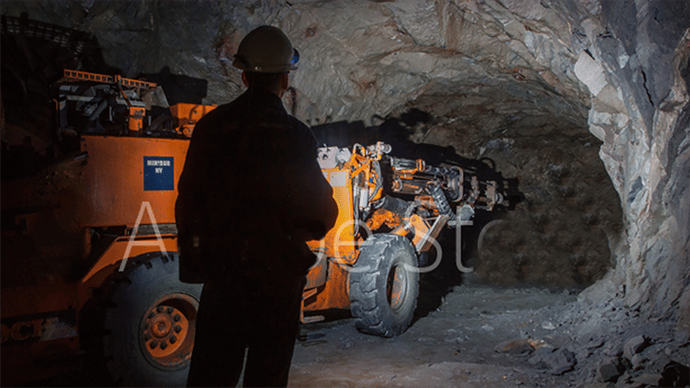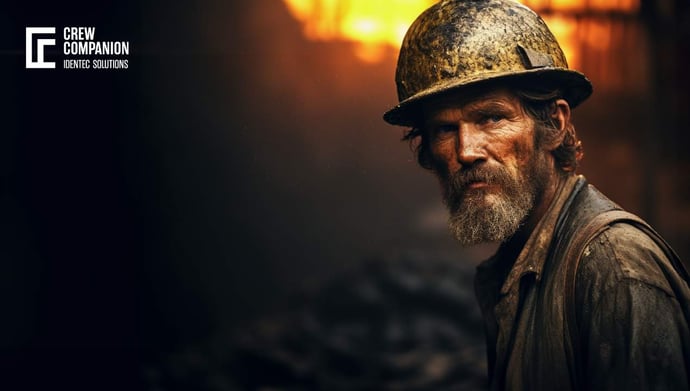Peruvian Mines: in the Top 10 Globally
| Written by Yeudiel Valdivia
Mining is an economically significant sector in Peru, contributing around 11% to the country's total production and 57% of its export value. Of all mining exports, copper represents the largest share at 52%, followed by gold at 27% and zinc at 7%.
Due to its geological diversity, Peru ranks among the top eight mineral-producing countries in the world in terms of both quantity and variety of minerals. Currently, over 130 underground mines are operating across the country. While their production is important, it does not match the output of open-pit operations. According to the Ministry of Energy and Mines (MINEM), underground mining involves a larger number of operations than surface mining, representing almost 65% of all mining units.

No video selected
Select a video type in the sidebar.
Peruvian Mines and Its Contribution to the Country's Development
Mining plays a crucial role in Peru's macroeconomic stability and fiscal balance by attracting foreign direct investment and generating public revenue. In 2022, a period of strong expansion ended with the completion of the Quellaveco mine, a project requiring more than $5 billion in investment, alongside smaller mines.
Copper is Peru's main metal, and after a 60% price rise in less than a year following the pandemic, it is expected to maintain good prices due to its value in clean energy technologies. Besides copper projects worth $37 billion, Peru also presents significant opportunities in lithium, a key metal for the energy transition. However, effective regulation is necessary to create economic, social, and environmental incentives for lithium exploitation.
THE POSITIVE IMPACT OF MINING IN PERU
Mining drives the industrialization of the country by continuously acquiring goods and services from other economic sectors, such as manufacturing, and impacts the transportation sector by moving inputs, minerals, and other tradeable goods. In summary, mining promotes diversification and the productive integration of various economic sectors, creating a value chain from mineral extraction to global delivery.
Moreover, mining's ability to generate formal employment is essential for economic recovery, especially given the additional jobs created across other sectors due to its value chain. According to estimates by the Peruvian Institute of Economics (IPE), for every direct mining job, an additional 6.25 jobs are created in the broader economy: 1 indirect job, 3.25 from consumption, and 2 from investment effects. This amounts to an estimated total of 4.6 million direct and indirect jobs linked to mining.
The Peruvian mines also facilitate regional access to financial resources. By August 2020, investments in the Quellaveco, Mina Justa, and Toromocho expansion projects had exceeded $2.55 billion. There is a direct correlation between poverty reduction and mining-related income, which has decreased poverty by about 15% over 20 years. Among the five regions with the highest per capita income (Arequipa, Moquegua, Pasco, Tacna, and Lima), four have significant mining activities.
Peru's geological potential and low operating costs make it highly competitive. However, social conflicts may affect the sector's competitiveness and its ability to attract investment.
What is the STRENGTH OF PERUVIAN MINES?
Several factors demonstrate the strength of Peru's mining industry, including the sustained high levels of investment in both underground and open-pit mining, increased polymetallic production led by copper, export levels, and its contribution to public finances. Additionally, formal private economic activities in rural and remote areas, often with high poverty rates, are crucial to the country's development.
Between 2009 and 2018, mining generated 20% of the applicable tax revenue and financed around $12 billion in transfers to regional and municipal governments. Mining also decentralizes economic activity, benefiting rural regions.
Mining has been vital for Peru's macroeconomic performance over the last two decades as the main generator of foreign exchange through exports and capital flows from foreign direct investment. See also: Responsible mining in Latin America
CHALLENGES AND OPPORTUNITIES IN PERUVIAN MINING
While Peru boasts vast mining resources, fostering investment, its competitiveness could improve through regulation, technological modernization, and social responsibility. The sector faces the challenge of creating favourable conditions for advancing its extensive portfolio of mining projects. Environmental sustainability and social impact must be improved to facilitate exploration, project development, and current operations, as mining investment suffers from a lack of social acceptance.
In recent years, uncertainties and distrust among national and international investors have emerged, threatening the constitutional principles of free enterprise, equal conditions, and property rights. Strengthening state institutions and the legal framework to encourage investment is crucial, as legal certainty is key to long-term mining projects.
Another major issue is illegal mining. Rising metal prices and limited employment opportunities have spurred the expansion of illegal mining, which uses artisanal methods that harm the environment and biodiversity. This has led to public opposition to mining in general without distinguishing between legal and illegal operations. Strengthening state institutions to control these actors and formalize them is essential.
Collaboration initiatives also offer great potential. They enable companies of all sizes to work together on common challenges, such as environmental, social, and energy issues, achieving objectives that would be difficult to accomplish alone.
Where do we find UNDERGROUND MINES IN PERU?
Underground mining involves extracting minerals beneath the Earth's surface instead of open-pit mining on the surface. Tunnels, galleries, and shafts are dug to access underground mineral deposits. This method is used to extract a variety of minerals, including gold, silver, copper, iron, and zinc, as well as non-metallic minerals like coal, salt, and limestone. Underground mining is important in the global mining industry and is used in countries worldwide.
Underground mining is challenging, requiring the construction of tunnels, shafts, and support structures, with technology serving as a key ally for safety and efficiency. Peruvian mining engineering has continuously improved, extending production at mines such as Porvenir (Pasco), Uchucchacua (Arequipa), and Animón (Junín), where operations have continued for over four years, progressively deepening galleries to maximize geological advantages.

According to MINEM's production map, most underground mines are polymetallic (copper, zinc, silver, and lead). These operations face challenges such as ventilation systems to remove dust and harmful gases, temperature control, and tunnel stability through reinforced concrete, metal support, and other materials.
The machinery used in underground mining differs from open-pit equipment due to size constraints in tunnels. Specialized personnel are needed for areas like underground support, ventilation, and equipment automation.
Innovation and digitalization are critical for the future of mining, from exploration to construction and production stages. To reduce accidents and ensure miner safety, technology advancements include high-temperature-resistant equipment, sensors to monitor workers' body temperatures, real-time tracking systems, and sensors that monitor rock movements during excavation.
While improving miner safety, underground projects are expanding and becoming more productive, demonstrating how technology is raising expectations in this key sector of Peru's economy.
Some of the most important underground mines in Peru include:
- Antamina Mine (Ancash): One of Peru's largest underground mines, producing copper, zinc, silver, and molybdenum.
- Cerro Verde Mine (Arequipa): Producing copper, molybdenum, and silver.
- Yanacocha Mine (Cajamarca): One of South America's largest underground mines, primarily producing gold.
- Toquepala Mine (Tacna): A copper producer.
- Antapaccay Mine (Cusco): Owned by Glencore, producing copper and molybdenum.
- Cerro Corona Mine (Cajamarca): Owned by Gold Fields, producing gold and copper.
- Yauricocha Mine (Lima): Owned by Sierra Metals, producing silver, zinc, and lead.
- Yauliyacu Mine (Lima): Owned by Los Quenuales.
FAQ
Which regions lead copper production in Peru?
Arequipa, Moquegua, and Ancash lead with a combined 50% share. Major contributing companies include Sociedad Minera Cerro Verde, Compañía Minera Antamina, and Southern Peru Copper Corporation.
What percentage of total production in Peruvian mines is represented by underground mines?
Although there are more underground mines than open-pit ones, underground mining accounts for only around 22% of the country's total mining production.
What are the main gold mines in the country?
Yanacocha, Compañía Minera Poderosa, and Consorcio Minero Horizonte stand out in gold extraction.
If you are interested in South America mines, continue reading about mining in Bolivia.
TAKEAWAY
With its vast geological potential, Peruvian mines have consistently attracted mining investment for exploration and project development since reforming their mining code in the 1990s. Underground mining plays an important role in sector development, partly due to its lower environmental impact—a significant factor given the sector's current challenges with social acceptance and legitimacy, which have led to protests against mining projects.
Continue reading about mining safety equipment
Delve deeper into one of our core topics: Miner Safety
Glossary
The Ministry of Energy and Mines (Spanish: Ministerio de Energía y Minas, MINEM) - oversees Peru’s energy and mining sectors, ensuring equitable energy distribution. As of February 13, 2024, Rómulo Mucho Mamani serves as Minister of Energy. MINEM’s objectives include promoting efficient, competitive energy resource use, supporting decentralization, private investment, and rural electrification with alternative energy. It also fosters mining sector growth through legal stability, clean technologies in small-scale mining, and environmental protection. Additionally, the ministry encourages strong relations between companies, consumers, and civil society, while focusing on strategic planning and effective resource management for sustainable development. (3)
Sources:
(1) https://www.mining-technology.com/marketdata/five-largest-zinc-mines-peru/
(2) https://miningdataonline.com/property/1932/El-Porvenir-Mine.aspx
(3) https://eulacfoundation.org/en/peruvian-ministry-energy-and-mining-mem
Note: This article was updated on the 12th of February 2025

Author
Yeudiel Valdivia, VP Sales Safe Mining
Yeudiel Valdivia holds a Master’s degree in Engineering (Telecommunications) and a Bachelor of Electrical and Electronic Engineering. He spent most of his professional career in sales and business development for industry segments including mining. Yeudiel is fascinated by the positive impact of technology in people’s life and how people can work safer and under better conditions, he is interested in how technology can transform businesses making them more efficient, agile, and productive and its potential for the economy growth in countries and regions. Yeudiel writes mainly about the digitalization of industries, driven by advancements in technology enabling new business models.
Related Articles
Related Product




